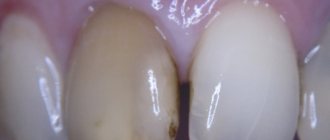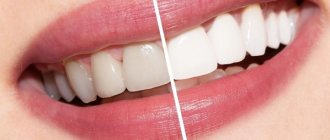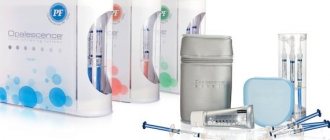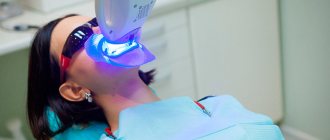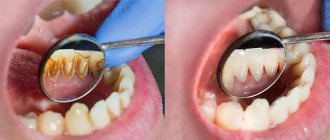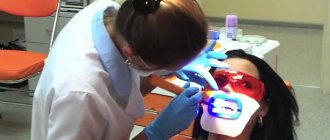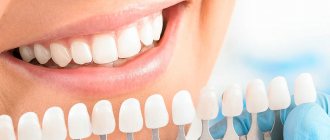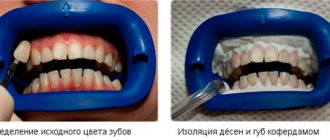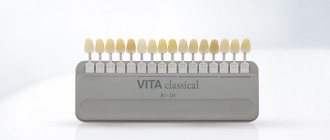A beautiful smile is everyone’s dream, but there are many factors that prevent this desire from being realized. Most people face the following problems:
- yellow enamel from nature;
- darkening of teeth due to age-related changes in the body;
- change in the color of crowns after treatment of long-term diseases.
These are only part of the reasons why crowns take on a shade that is far from the standards of a Hollywood smile. What to do? Whiten your teeth! Dentistry knows methods that return enamel to its natural whiteness.
About the features
Among the techniques that allow achieving lightening, restorative bleaching stands out. The doctor does not use traditional means of making crowns white:
- gels;
- pastes;
- ultraviolet lamp;
- laser.
Instead, super-thin plates are placed on the teeth, changing their natural color and correcting defects in shape. Restoration involves fixing a protective plate to the front surface.
As a result, the teeth acquire a white color, the shade of which is chosen by the patient himself, become smoother and are protected from external factors (sour, sweet, coloring foods and drinks that destroy the enamel).
The initial state
If the patient wishes, the doctor can always change the plates or return the teeth to their original state. This is very important, since sometimes the shade of the plate chosen by the patient turns out to be too white in practice and can burden the owner of this smile. In the case of ceramic veneers, fixing this will be quite expensive and difficult, but the plates can be easily adjusted by simply choosing a new color. And if a person is completely satisfied with the results of restorative bleaching, then in the future one can use porcelain or zirconium dioxide, which are the most durable materials.
Advantages
The new method has many “advantages” that give it growing popularity. This:
- no chance of damaging the enamel (which we take into account when using methods that involve chemical exposure);
- painlessness;
- independent choice of color;
- effect immediately, after one procedure;
- service life without the need for correction is 10 years.
After removing the whitening film, the teeth remain the same as they were before the correction.
Thinning of the enamel, signs of caries and other problems will not arise. Who is the procedure suitable for? Dentists recommend it to people who are not suitable for less radical methods, as well as to those whose crowns are thin and cannot withstand the application of whitening gels.
If a person has previously been overly keen on whitening and has suffered a complication in the form of enamel demineralization, doctors will advise him to switch to a restorative technique.
Chips and cracks in the front teeth are difficult to heal, since fillings on those surfaces that come into contact when chewing do not hold. To prevent further tooth decay, the dentist will perform restorative bleaching - in this case, it will serve as an alternative to a filling.
Difference from other dental procedures: a patient who does not like the result can always return to the original option. To do this, he needs to make an appointment with the dentist and ask to remove the protective film.
How to consolidate the result
In order for the aesthetic effect to last for a long time, after the procedure the patient should follow some rules:
- visit the dentist regularly;
- refuse to use ultrasonic cleaning;
- exclude hard, coloring and stretchy foods;
- observe the rules of oral hygiene.
If you follow the rules and recommendations, lamination will last a long time and its service life will last more than ten years. If one of the plates comes off or is damaged, it can be replaced without any complications or consequences.
Order of conduct
The procedure is carried out in one go. But before setting a date for the client’s “magical transformation,” the doctor examines the oral cavity for the presence or absence of caries and inflammatory diseases. For some, the preparatory stage takes one session, for others it lasts for 2,3, or 5 visits. Restorative bleaching is not carried out until the oral cavity has been sanitized. Next, the doctor begins restoration.
Two methods are used.
The first method is using composite materials.
- The teeth are ground down (sometimes with anesthesia).
- Dry the jaws with a halogen lamp.
- A varnish is applied to the teeth, which gives a white color.
This way, unevenness is eliminated and a natural lightening effect is created.
The second method is with the installation of lumineers.
The doctor attaches 0.3 mm thick plates to the crowns of the front teeth. It’s hard to even imagine such thickness!
Material from which lumineers are made:
- phosphorus;
- ceramics;
- plastic.
The teeth are not ground down. The dentist first takes impressions of the jaws so that the lumineers are perfectly tailored to the specific patient. Then the plates are placed on the teeth. The last stage is polishing.
Other whitening techniques using restorations
- Veneers
are overlays made of ceramic, porcelain or composite materials up to 1.5 millimeters thick that replace the outer layer of teeth. Unlike lumineers, they allow you to change the shape of your teeth, hide chipped enamel and even correct minor bite defects, but require preliminary grinding of the enamel. - Ultraneers
are medium-thick plates (thinner than veneers, but thicker than lumineers) up to 0.5 millimeters. Used to restore aesthetics and correct enamel defects. Unlike lumineers, which are placed on at least 8 teeth in a row, they are suitable for local elimination of defects. - Componeers
are a new class of plates that are made from a nanohybrid composite. This restoration method provides high aesthetics and durability, but also requires preliminary grinding of the enamel.
Reviews
For those who are thinking about the advantages and disadvantages of restorative bleaching, it is useful to read the reviews of people who have already “tried on” the fashionable novelty.
Alexei
“My teeth are strong, but yellow. What I didn’t do: I tried “chemistry”, laser, homemade pastes. The result lasts for six months - and the enamel returns to its previous state. In addition, I don’t like chips on my upper teeth - don’t sharpen them, as this will cause further spread of cracks. The dentist recommended restorative bleaching. I chose composite veneers - I don’t regret it. I haven’t had any problems with my teeth for the last three years.”
Kate
“My 3 upper teeth turned dark because the nerves had to be removed. And between them there are gaps. I performed restorative whitening – now I have an almost Hollywood smile!”
Hope
“My enamel became fragile after pregnancy and childbirth. To prevent decay and give a white color, the dentist recommended bleaching with lumineers. I had plates installed and now my teeth look better than before pregnancy. And the sensitivity has decreased."
Photos before and after
In the photo, the difference between the initial state of the teeth and after whitening is clearly visible. This effect can be achieved by anyone who wants to try out a new technique.
Restorative teeth whitening in dental clinics in Moscow
- President prestige
- 6th street New Gardens, building 2, bldg. 1
- +7 (499) 938-… show all
- Mon, Tue 9:00–21:00; Wed 9:00–18:00; th-
3.6 ratings: 8
- Stomach Avenue
4.5 ratings: 10
- kind hands
3.8 ratings: 5
- Clinic on Pokrovka
3.8 ratings: 5
- Cosmetic dent
3.8 ratings: 5
- Dental clinic Mirana Dent
4.8 ratings: 4
- Agami
4.3 ratings: 9
- Avantis
4.2 ratings: 11
- 32 den
4.7 ratings: 9
- Dental Implantology and Surgery Clinic refformat
4.4 ratings: 9
- Novadent
4.5 ratings: 4
- Orthodontist complex
4.6 ratings: 5
Further
Care
Restorative whitening has one more “advantage” that was not mentioned earlier: no special dental care is required .
Do you brush your teeth twice a day, use rinses, and don’t forget to floss from time to time to get rid of interdental plaque? These measures are sufficient to ensure care after restorative bleaching.
One small feature is added: do not indulge in hard and viscous food in order to extend the service life of the material of the protective plates.
Description of the procedure
We’ll look at prices for teeth whitening in dentistry below, and now let’s look at the procedure. It has five stages:
- Surfaces are cleaned of plaque and tartar, caries is treated, and, if necessary, old fillings are replaced.
- The surface of the incisors is thoroughly polished and coated with an antibacterial compound.
- The patient selects the color of the overlays using a special shade scale.
- The plates are fixed to the front tooth surface with an adhesive containing a therapeutic component that reduces sensitivity and helps prevent the accumulation of various bacteria.
- The overlays are polished, a micro-relief is created in order to give them an absolute resemblance to enamel.
Advice from Dr. Zubastik
We choose between different methods of teeth whitening. Restoration is one of them, and with almost no contraindications: it is not used for large defects or untreated diseases. You can watch the installation process in this video:
For me, it’s a big “plus”: you don’t need to interfere with the structure of the enamel or expose it to chemicals. It is also convenient that the plates can be removed when treatment or examination is required. I recommend this method to those who want to lighten their teeth without the risk of damaging the enamel.
Tags: lumineers, whitening, restorative whitening
About the author: Dr. Zubastik
Typically, a toothache begins to subside on the way to the clinic and finally goes away after 10 minutes of sitting in line to see the dentist.
- Related Posts
- Top 15 questions about braces and the same number of expert answers
- Chemical bleaching: effective or dangerous
- Dental implantation: everything about the operation and its consequences is brief and clear
« Previous entry
Comments
Is it possible to immediately do restoration after regular whitening if you are not satisfied with the result?
Svetlana (02.10.2020 at 22:54) Reply to comment
- To eliminate serious color pigmentation, spots, as well as to correct other defects, doctors often combine methods of classical and restorative bleaching. If this is indicated, the classic enamel lightening is first carried out, after which the teeth are given time to recover and strengthen, and after 2-4 weeks restorations are performed.
Editorial staff of the portal UltraSmile.ru (05.10.2020 at 09:14) Reply to comment
